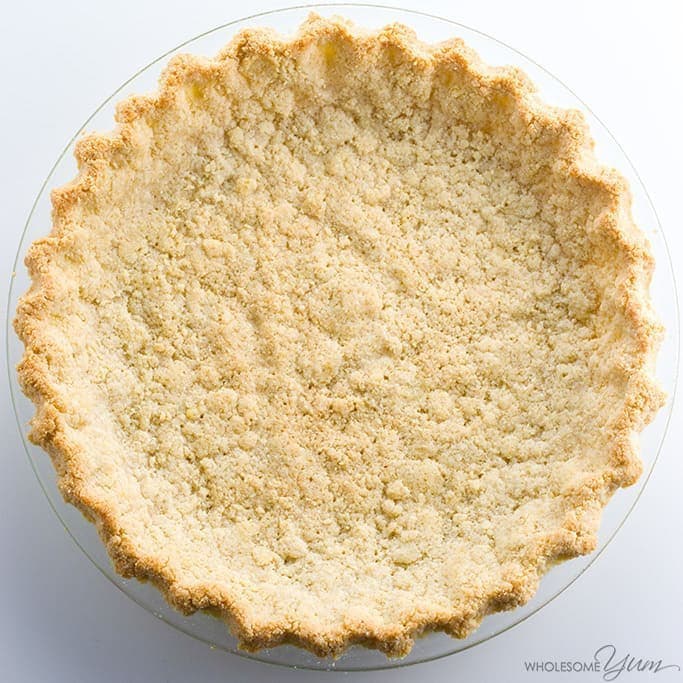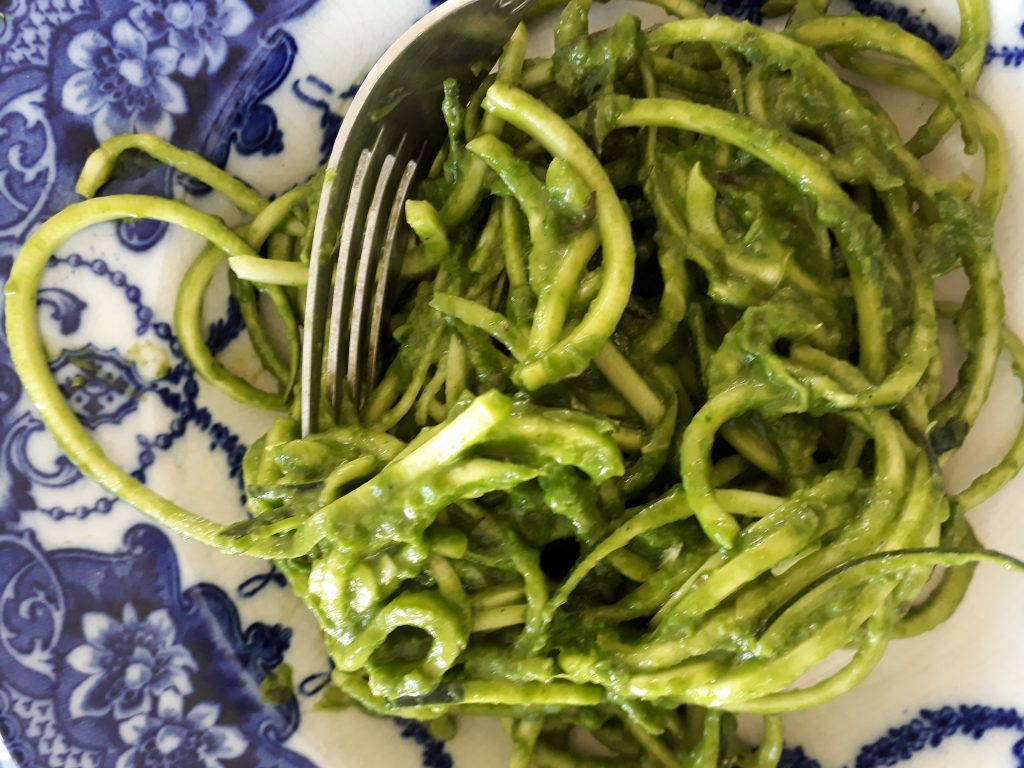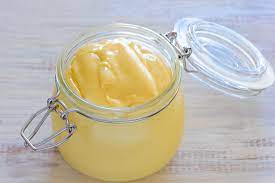
Dec 8, 2022 | Anna's Best Recipes, Cakes, biscuits & bars
Naturally gluten-free and grain-free, I really like these. This recipe is from Raman Prasad’s Specific Carbohydrate Diet Cookbook. The SC diet can be magical for getting people with inflammatory bowel conditions into remission while they start to work on the underlying causes. But the recipes in it are pretty tasty for anyone and much less damaging for the gut.
Makes 40-50 cookies.
- 112g (8 tbs) melted butter
- 1 large egg
- 1 tsp water
- 80g (1/4 cup) honey
- 1 level tsp ground allspice
- 2 rounded tsp ground ginger
- 1 level tsp ground Ceylon cinnamon
- 1 heaped tbs peeled and finely grated fresh ginger
- 1 rounded tsp bread soda (also called baking soda/bicarbonate)
- 330g (3 cups) almond flour/ground almonds
1. Preheat oven to 180C (165C fan). Grease 2 baking sheets.
2. Mix all the ingredients together in a bowl until the dough is dry enough and not stick to work with. Add more almond flour/ground almonds I needed.
3. On the baking sheet, form 4-5 cm circular mounds with the dough and press down to flatten into a cookie shape.
4. Bake 10-15 mins until the edged turn golden.
Why this is better for you:
These biscuits are naturally grain-free, which is great news for anyone struggling with Crohn’s, colitis or who may be on the SC diet during a IBS/SIBO recovery protocol. These are also high in protein (almonds) and much lower in sugars (honey) so they don’t cause blood sugar peaks and troughs. A word of warning though, these are treats, not everyday foods. This is because nuts, when roasted, no longer contain healthy oils. So eating too many of these is not good for your metabolism.

Mar 31, 2022 | Anna's Best Recipes, Main courses, Sides, starters, soups & snacks
Just invented this last week from what we had in the fridge. It’s LOVELY with its blend of salty, smokey and fresh flavours. Lovely with a fresh mixed salad. Make sure to buy actual feta which is made from ewe (sheep) or goat milk. Do try to avoid the nasty pitted olives in black water available in supermarkets – they have almost no flavour and are only black because of black food dye. If you want to save, get your black olives in middle Eastern shops where they’re great value.
I don’t add the mint until just before serving as it goes limp quickly.
1 packet (around 200g) feta, cut in bite sized cubes as small as you like
1 large aubergine
Heaped teaspoon (or more) ground coriander
3 dsp extra virgin olive oil (EVOO)
1 dsp lemon juice or apple cider vinegar
Freshly ground black pepper
Handful un-pitted olives (ideally wrinkly dry black ones or kalamata)
Generous handful washed mint leaves
- Turn on grill to high.
- Slice an aubergine in 1cm (or a bit thinner) slices (disks or lengthways, whatever you prefer).
- Put aubergine slices on grill, brush with extra virgin olive oil (EVOO) and sprinkle with a little ground coriander. Grill till golden while you assemble the other ingredients. Then turn and repeat the process. Remove from heat and allow to cool slightly. Cut into bite size pieces or strips (I use a scissors to do this quickly).
- Into a large serving bowl put aubergine, olives, feta, EVOO, lemon juice/vinegar and a few generous grinds of black pepper and gently mix everything.
- Just before serving chop the mint. Sprinkle it over the top or mix it in.
Serve with:
Low carb: A big mixed salad dressed with my favourite dressing https://www.annacollins.ie/mediterranean-salad-dressing/
Medium carb: Salad + something starchy like wholemeal gluten-free bread or (for gluten eaters) a nice wholemeal rye sourdough.
Why this is good for you (provided you’re not dairy-sensitive!):
Goats and sheep’s cheese are high in protein and FAR more easy for humans to digest than cow. Modern (Jersey) cow’s milk contains A1 beta casein which is hard to digest. Goat and sheep milk contains 80% less of this problematic casein. Olives are a fermented food and contain beneficial bacteria to help your gut. Mint, like most herbs/spices, helps make your gut a hostile place for disease-causing bacteria and is also rich in polyphenols. Polyphenols are natural plant compounds shown to be anti-inflammatory, anti-oxidant and hugely supportive of your health – gut, brain, skin and more. What’s not to like?

Nov 30, 2021 | Anna's Best Recipes, Cakes, biscuits & bars, Desserts & drinks
This is perfect for your SC diet if you want to make a delicious pastry-based dessert. I’ve adapted it for metric from the original Us recipe. Thank you to Jen Brown for her original recipe at https://www.alifeofhappenstance.com/easy-almond-flour-pie-crust/
This case can be pre-baked up to two days before planning to fill it. Simply cover with tinfoil or eco-friendly wrap and store in the fridge.
If your system can handle dairy, butter (or better still, clarified butter) can be used in place of coconut oil.
240g blanched finely ground almond flour (I blitz ground almonds for a few minutes in the food processor to get it nice and fine)
½ teaspoon salt
55g melted coconut oil (make sure it’s not hot)
1 large egg
9″/23cm tart case/pie dish or deep pyrex plate (+ extra coconut oil to grease)
1. Preheat oven to 175C/160C fan and grease a 9 inch/ pie dish. Set aside.
2. In a small bowl whisk together the melted coconut oil and egg. In a large bowl whisk the almond flour and salt. Pour the wet ingredients into the dry and use a rubber spatula or your hands to combine.
3. Form the dough into a ball and place in the center of the greased tart case. Use your hands to evenly press the dough into the bottom of the tin or dish.
4. Evenly press the dough up the sides of the tart case. If it seems a bit thinner in certain areas, simply take some dough from the thicker areas and press it where needed.
5. Once the dough has been pressed into the bottom and sides of the tart case, use your fingers to make sure the edge of the pastry is even all along the top. Then you can use a fork to press decorations into the crust or use your fingers to make a fluted design with the edge.
6. Use a fork to poke holes along the bottom and sides of the crust before placing on the middle rack of the oven and baking for 12 to 15 minutes. The case should be a very light golden brown.
7. Allow to cool completely before filling.

Apr 29, 2020 | Anna's Best Recipes, Main courses, Sides, starters, soups & snacks
I wish I could claim this idea as my own but every supermarket now sells spiralized courgettes for you to use instead of pasta. The oil and salt lift courgetti from being worthy to being delicious. I used to make a lot of wholemeal pasta dinners until I studied nutrition. Then I realised the large proportion of starchy foods in meals was contributing to my fatigue, frequent infections and poor stress tolerance. Rebalancing my plate helped me enormously within days.
For 2 people
2 medium courgettes
2 dsp extra virgin olive oil (more if you want!)
Pinch of Himalayan salt or sea salt
1. Make long strands of courgette: Either grate them lengthways (skin and all) on the big side of your grater or use a spiralizer.
2. Heat a frying pan on a medium heat. Add the olive oil, the courgetti and scatter over a generous pinch of salt.
3. Now heat, stirring every so often, for around 5 minutes. You want them heated, VERY slightly softened, but not so soft they release water and go into a bit of a mush. It took me a few tries to get this right!
4. Serve immediately with your pasta sauce. Enjoy!
 Why this is good for you:
Why this is good for you:
When we eat more than 1/4 of our lunch and dinner as high carb foods (e.g. pasta, potatoes, bread) it makes us more likely to struggle with poor detoxification (acne, PMS, headaches or fatigue anyone?). Your body stores excessive sugars as fat and this is why reducing carbohydrates to modest levels helps so quickly in getting you to your ideal weight. Farmers know that one of the fastest ways of fattening their livestock for market is to switch from grass-feeding to grain-feeding. Excessive sugars come not only from “healthy” grains, potatoes and fruit juice but also (even more) from added sugar foods like biscuits, cakes and “fruit juice drinks”.
About wheat pasta: Did you know that gluten breeches the lining of your small intestine within minutes of reaching it? This allows gut bacteria, waste and undigested food to flood into your bloodstream. It’s called increased intestinal permeability and lasts for a minimum of 3 hours. This has been proven by ground-breaking research using capsule video cameras swallowed by HEALTHY STUDY VOLUNTEERS. This is not related to gluten sensitivity or coeliac disease. It happens to everyone though its effects are more serious in those groups. So finding ways to lower gluten in our daily eating is a great way of moving towards better health. Looking after your gut lining makes you less likely to suffer sepsis should you become very ill with an infection. Low gluten grain choices include sourdough bread and oats. If you have an autoimmune condition like hypothyroidism (90% is autoimmune) you will need to switch to naturally (not highly processed!) gluten-free options.

Jul 15, 2019 | Anna's Best Recipes, Dressings, rubs, spreads, sauces & more
I have to say this is the most delicious mayo recipe I have ever tasted. I so enjoyed it with steamed asparagus and a couple of boiled eggs for lunch today. Personally I like using a half and half mix of extra virgin sunflower/sesame and olive oils. Extra virgin sesame oil has a neutral flavour similar to sunflower, in my opinion. Nothing like the usual sesame oil, which is super heat-treated. Dijon mustard, salt and herbs preserve the mayo longer. When its gone over, you’ll know because it will have separated or gone runny. One yolk will bind up to 1 litre of oil so for a bigger batch you only need to increase the other ingredients.
1 medium/large organic egg yolk, at room temperature
1 tbs Dijon mustard, at room temperature
230ml extra virgin (cold-pressed) oil: olive, rape, sunflower or avocado
1 dsp apple cider vinegar or lemon juice
Himalayan salt
Pepper
Optional: 2 tablespoons herbs to add at the very end: e.g. fresh chopped tarragon,parsley, coriander or chives.
- Bring the egg and mustard to room temperature in advance (chilled eggs/Dijon will leave you with a runny, disappointing sauce!).
- Mix the egg and mustard with a stick blender or whisk and while whisking add the oil slowly in a thin stream (this is essential). The mayo should start to thicken. Many food processors now have a cap on top that has a small hole for this purpose.
- Continue whisking and adding until the oil is used up and the mayo is set.
- Add vinegar/lemon juice. Mix some more and season with salt and pepper and whatever herbs you are using.
- Let the mayonnaise rest in the fridge before serving – this allows the flavour to develop and the mayonnaise to thicken further.
Why this is better for you:
As you’ll know if you’ve been a client of mine, omega 6 oils in the form most people eat them, are toxic. Omega 6 oils like sunflower, rape, safflower, sesame, canola, soya and “vegetable oil” are heat treated to give them a long shelf life. This makes their chemical structure change to one that interferes with metabolic functions as they are incorporated into our cell membranes in EVERY tissue of our body. They are used as cooking oils, and to make bread, cakes, biscuits and confectionary and of course in ready meals, to give them a nice mouth feel.
So if you’d like to avoid or reduce chronic health conditions, swapping out your heat-treated nut and seed oils for healthier options is a winner. For food prep use either extra virgin olive oil or (never cooked) extra virgin nut/seed oils like sesame, sunflower, rape, walnut and hazelnut. Commercial mayonnaise is ALWAYS MADE WITH REFINED OILS (if you find one that’s not, do let me know so I can tell everyone!). Bottom line, we are all deficient in these life-giving untreated, never heated, omega 6 oils. DID YOU KNOW that mustard can be a powerful tool against eczema (dermatitis)? A study a few years ago showed that eating mustard daily prevented eczema in mice. Who knew??






